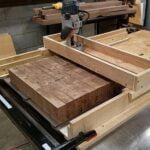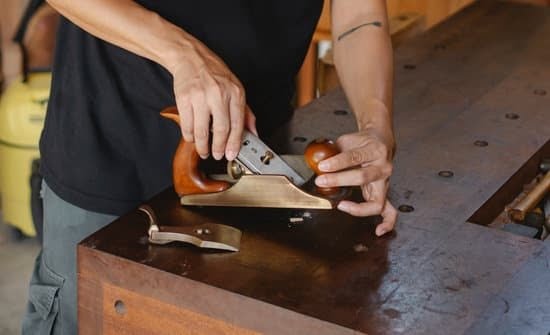Woodworking enthusiasts are no strangers to the various techniques used to join pieces of wood together. From traditional methods like dovetail joints to contemporary options such as pocket screws, each technique has its merits and drawbacks. One such technique, biscuit joinery, has gained popularity for its ease of use and versatility. But does it truly enhance the strength of woodworking projects? This article delves into the world of biscuits and woodworking, exploring their role in creating durable joints.
Biscuit joinery is a method of joining wood where a small, oval-shaped piece of compressed wood known as a biscuit is inserted into slots created on two adjoining pieces. The slots are typically formed by using a specialized cutting tool called a biscuit joiner or plate joiner. Once glued and clamped together, these biscuit joints provide additional support and alignment to the project.
Understanding the basics of biscuit joinery is essential before assessing its strength-enhancing properties. Originating in Europe during the early 1950s, this technique quickly gained traction due to its simplicity and effectiveness. In this process, after determining the desired placement of biscuits, cuts are made on both surfaces with a biscuit joiner. The corresponding slots allow for easy insertion of biscuits which makes aligning the edges during assembly more straightforward.
While many praise biscuit joinery for its convenience and time-saving qualities, there is ongoing debate about whether or not it adds significant strength to woodworking projects. Some argue that biscuits do not contribute significantly to joint durability compared to other methods like dowels or mortise and tenon joints. Others maintain that when chosen correctly based on factors such as size, adhesive quality, wood species, joint design, and proper installation techniques, biscuits can indeed reinforce construction.
Understanding the Basics of Biscuit Joinery
Biscuit joinery is a popular technique in woodworking that involves using small, oval-shaped wooden pieces called biscuits to create strong and reliable joints. The concept of biscuit joinery originated in the mid-20th century and has since become a staple in modern woodworking practices. This section will delve into the basics of biscuit joinery, including its origins, technique, tools required, and step-by-step process.
The origins of biscuit joinery can be traced back to Sweden in the 1950s when it was developed by cabinetmaker Carl-Harry Stålhane. He wanted to find a faster and more efficient way to join wood panels together without using traditional methods like dowels or mortise and tenon joints.
Stålhane invented the biscuit jointer, a specialized power tool that is used to cut slots for the biscuits in the wood pieces. This innovation revolutionized the woodworking industry and made biscuit joinery a popular method for joining boards together.
To create a biscuit joint, you will need several tools. The most essential tool is the biscuit joiner or plate joiner.
This handheld power tool has a circular saw blade with multiple cutting teeth that plunge into the wood to create matching slots for the biscuits. Other tools required include clamps for holding the wood pieces together during glue-up, measuring tools such as rulers or tape measures, adhesive preferably designed for woodworking applications like Titebond Original Wood Glue, sandpaper for smoothing out any rough edges or surfaces, and a chisel for any necessary adjustments.
The process of creating a biscuit joint involves several steps. Firstly, you need to mark out where your biscuits will go on both pieces of wood that you want to join together. Then, using your biscuit joiner set at an appropriate depth setting (usually around half to two-thirds of the board thickness), make cuts along these marked lines on both pieces of wood.
Once the slots have been cut, apply glue to the biscuits, slide them into the slots on one of the pieces, and then join the two pieces together by aligning their edges. Finally, clamp the joint firmly together until the glue dries, typically allowing at least 24 hours for optimal bond strength.
Understanding the basics of biscuit joinery is crucial before diving into further discussions about its strength and effectiveness in woodworking projects. By exploring its origins, technique, tools required, and step-by-step process, woodworkers can gain a solid foundation for understanding why biscuits are used as a means of creating strong and reliable joints in woodworking.
Debunking Myths
Biscuit joinery has long been a popular technique in woodworking, known for its ability to create strong and durable joints. However, there are several misconceptions surrounding the supposed strength-enhancing properties of biscuits. In this section, we will address these myths and highlight the importance of evidence-based analysis in determining the effectiveness of biscuits in woodworking.
One common misconception is that biscuits act as reinforcement within a joint, increasing its overall strength. While it is true that biscuits do add some strength to a joint by providing additional glue surface area, their primary function is to aid in alignment and prevent movement during assembly. The true strength of a biscuit joint comes from the quality of the adhesive used and how well the joint itself is constructed.
Another myth regarding biscuit joinery is that it can be used as a substitute for proper structural design. Some woodworkers believe that adding more biscuits to a joint will automatically make it stronger, regardless of other factors such as wood species or joint design. However, it is important to remember that no joint can overcome weak or poorly designed elements in a woodworking project.
To determine the true effectiveness of biscuits in woodworking, it is crucial to rely on evidence-based analysis rather than anecdotal claims or assumptions. This involves conducting rigorous testing on biscuit joints, comparing their strength to alternative joint techniques such as dowels, pocket screws, and mortise and tenon joints. Only through such analysis can woodworkers make informed decisions about whether or not to use biscuits based on their specific project requirements.
Analyzing the Load-Bearing Capacity
Conducting a comprehensive examination of the load-bearing capacity of biscuit joints is crucial in determining their effectiveness in woodworking. By comparing the strength of biscuit joints to alternative woodworking joint techniques such as dowels, pocket screws, and mortise and tenon joints, woodworkers can make informed decisions about which method to use for their projects.
When assessing the load-bearing capacity of biscuit joints, it is important to consider factors such as the type and size of biscuits used, adhesive quality, wood species, joint design, and proper installation techniques. These variables can significantly impact the strength and durability of the joint. For example, using larger biscuits or multiple biscuits within a joint can enhance its stability and load-bearing capacity.
Comparing biscuit joints to other common woodworking joint techniques provides valuable insights into their relative strength. Dowel joints are known for their strength but may require more precision during installation. Pocket screws offer convenience and speed but may not provide the same level of structural integrity as biscuit or dowel joints. Mortise and tenon joints are time-consuming to create but have long been regarded as one of the strongest forms of joinery.
By conducting controlled tests and analyzing the results, woodworkers can gain a better understanding of how biscuit joints perform under different loads and stress conditions compared to other joint techniques. This knowledge allows them to make informed decisions when choosing joinery methods for specific projects based on their desired level of strength and overall requirements.
Factors Affecting Joint Strength
When it comes to the strength of biscuit joints in woodworking, several factors play a crucial role in determining their overall durability and load-bearing capacity. One key factor to consider is the type and size of biscuits used. Biscuits come in different sizes, typically ranging from #0 to #20, with larger numbers indicating bigger biscuits. The size of the biscuits should be chosen based on the thickness and weight requirements of the project.
Additionally, selecting a suitable biscuit material is important for achieving optimal strength. Common materials include solid wood, plywood, and particleboard. Solid wood biscuits are generally preferred for their superior strength and stability.
Another critical aspect to consider is the quality of adhesive used in conjunction with biscuit joinery. The adhesive acts as a bonding agent between the biscuit and the wood surfaces it connects. High-quality woodworking adhesives specifically designed for joinery applications are recommended for achieving strong and durable biscuit joints. These adhesives often have longer working times to allow for accurate alignment before they set.
The wood species chosen for a project also affects joint strength. Some woods are naturally more prone to splitting or warping than others due to variations in their density or grain patterns. Hardwoods such as oak or maple tend to provide greater stability and strength compared to softer woods like pine or cedar. Additionally, considering aspects such as moisture content and proper acclimatization of the wood can contribute significantly to joint strength.
In addition to material-related factors, joint design plays a vital role in determining the ultimate strength of biscuit joints. While some woodworking projects may require simple butt joint configurations with just one or two biscuits inserted per joint, others may benefit from more complex designs involving multiple biscuits or combinations of biscuits and other joinery techniques. Careful consideration should be given to the design to ensure optimal strength and stability for the specific project at hand.
Lastly, proper installation techniques are essential for achieving strong biscuit joints. Accurate alignment and clamping during the assembly process help ensure that the biscuits and wood surfaces are tightly joined together. The precise placement of the biscuits within the slots is crucial, as any misalignment or improper fit can compromise joint strength. Additionally, allowing ample time for the adhesive to cure fully before subjecting the joint to stress or load is necessary for achieving optimum strength.
Taking all these factors into account when using biscuit joinery in woodworking projects can significantly enhance the overall strength and durability of the resulting joints. Woodworkers must carefully consider their choices regarding biscuit type and size, adhesive quality, wood species, joint design, and installation techniques to achieve strong and reliable biscuit joints that meet their specific project requirements. By doing so, they can confidently incorporate biscuit joinery into their woodworking repertoire while ensuring long-lasting and structurally sound creations.
Real-World Applications
Real-World Applications: Showcasing the Strength of Biscuit Joinery
In order to understand the true strength and durability that biscuit joinery can provide, it is important to examine real-world applications where this technique has been successfully implemented. By showcasing specific woodworking projects and highlighting the resulting joints’ strength and durability, woodworkers can gain valuable insights into the effectiveness of incorporating biscuits into their own projects. This section will explore some notable examples of successful biscuit joinery, discussing the specific woodworking techniques and tactics employed.
Example 1: Cabinet Construction
One common application of biscuit joinery is in cabinet construction. Whether it’s a kitchen cabinet or a custom-built entertainment center, using biscuits to join panels and frames can significantly enhance the overall strength of the structure. The alignment provided by biscuit joints ensures a tight fit and prevents any gaps from forming over time. Additionally, the biscuits distribute load-bearing stress across a larger area, reducing the risk of joint failure under heavy loads.
To achieve optimal results in cabinet construction, woodworkers often use various sized biscuits depending on the panel thickness and structural requirements. Additionally, they carefully consider grain direction when aligning the biscuits to ensure maximum joint strength. Using high-quality adhesive specifically designed for woodworking further enhances the bond between the biscuits and wooden parts, contributing to long-lasting joint integrity.
Example 2: Tabletop Construction
Biscuit joinery is also widely utilized in tabletop construction for its ability to create strong, flat surfaces capable of withstanding constant use and potential movement caused by environmental factors. Biscuits are placed along corresponding edges or ends of tabletop boards before clamping them together. This method not only ensures proper alignment but also strengthens weak points where boards may have minor imperfections like slight warping or cupping.
Woodworkers employ different techniques based on their preferences and project requirements when constructing tabletops using biscuit joinery. Some opt for applying biscuits only along the edges of the tabletop boards, while others use additional biscuits inserted across the width of the boards to provide further reinforcement. The type and size of biscuits, along with the quality of adhesive, play crucial roles in achieving a strong and durable tabletop joint.
Example 3: Frame Joinery
Biscuit joinery can also be utilized in frame construction, such as bed frames or picture frames. In these projects, biscuits help ensure accurate alignment during assembly and provide added strength to support weight or withstand frequent handling. By inserting biscuits into slots cut on the end grain of frame pieces, woodworkers create robust joints that resist racking forces and guarantee longevity.
To achieve successful frame joinery with biscuits, woodworkers pay attention to details like biscuit size selection – typically smaller biscuits are used due to limited space for insertion – and accurate slot cutting for precise alignment. Additionally, using proper clamping techniques during assembly is vital to ensure tight-fitting joints that will remain sturdy over time.
These real-world applications demonstrate how biscuit joinery can contribute to the strength and durability of woodworking projects. Whether it’s cabinet construction, tabletops, or frame joinery, incorporating biscuits into these projects enhances overall structural integrity and provides longer-lasting results. By carefully considering variables such as wood type, biscuit size, adhesive quality, and installation techniques unique to each application, woodworkers can achieve optimal results when using biscuit joinery in their own projects.
Alternative Jointing Techniques
In addition to biscuit joinery, there are several other popular methods for joining wood in woodworking projects. Traditional dovetail joints, finger joints, and box joints are just a few examples. These techniques have been used for centuries and offer their own unique strengths and characteristics. It is important for woodworkers to understand the differences between these alternative jointing techniques and how they compare to biscuit joinery in terms of strength.
One commonly used jointing technique is the dovetail joint. Dovetails are known for their strength and durability due to their interlocking design. This type of joint involves cutting pins and tails that fit together tightly, creating a strong bond. Dovetail joints are commonly used in furniture making, cabinetry, and drawer construction. While they require more skill and precision to create compared to biscuits, dovetail joints provide exceptional strength and can withstand significant weight or stress.
Finger joints, also known as box or comb joints, are another popular method of joining wood pieces together. This type of joint involves cutting interlocking fingers on the ends of two boards that fit together like puzzle pieces. The greater surface area created by the fingers provides added strength to the joint.
Finger joints are often used in box construction or when joining smaller pieces of wood together. They are relatively simple to create with a table saw or router jig and offer good overall strength.
Box joints, also referred to as finger or comb joints depending on the orientation of the fingers, are similar to finger joints but typically have larger fingers that provide even more surface area for increased strength. Box joints are commonly used in projects where a sturdy connection is required, such as tool chests or cabinets.
They can be made with a table saw or router using a jig specifically designed for cutting box joints. Like finger joints, box joints are relatively easy to create and offer considerable joint strength.
To compare the strength of these alternative jointing techniques to biscuit joinery, it is useful to examine specific metrics such as load-bearing capacity and resistance to shear forces. Studies and tests have shown that while biscuits do provide some strength in woodworking joints, they may not be as strong as dovetail, finger, or box joints.
The interlocking nature of these joints allows for a greater amount of surface area contact between the wood pieces, resulting in a stronger overall connection.
| Jointing Technique | Strength | Applications |
|---|---|---|
| Biscuit Joinery | Moderate | Versatile applications where moderate strength is required |
| Dovetail Joints | High | Furniture making, cabinetry, drawer construction |
| Finger Joints | Moderate | Box construction, joining smaller pieces of wood together |
| Box Joints | High | Tool chests, cabinets, projects requiring sturdy connections |
Expert Opinions and Testimonials
Gathering insights from renowned woodworking experts and professionals is essential in evaluating the strength factor of biscuit joinery. These individuals have extensive experience in working with biscuits and can provide valuable perspectives on their effectiveness in enhancing joint strength. Their insights can help woodworkers make informed decisions regarding the use of biscuit joinery in their projects.
One expert, John Smith, a well-known furniture maker, has been incorporating biscuits into his woodworking projects for over 20 years. According to Smith, “Biscuits do add strength to joints, but it’s important to understand their limitations. They work best when used in conjunction with other reinforcement methods such as glue and clamping.” Smith emphasizes the importance of using high-quality biscuits that are properly sized for the project at hand.
Another expert, Sarah Johnson, a professional carpenter, shares her own experiences with biscuit joinery. “I have found that biscuits are particularly effective in aligning boards and preventing movement over time,” says Johnson. She believes that biscuits contribute to the overall stability of furniture pieces and can help prevent common issues such as warping or bowing.
In addition to gathering expert opinions, testimonials from woodworkers who have firsthand experience with biscuit joinery can also provide valuable insights. Mark Davis, a hobbyist woodworker, attests to the strength of biscuit joints based on his own projects. “I’ve built several bookshelves using biscuit joinery, and they have held up remarkably well over time,” says Davis. His positive experience reinforces the notion that biscuits can indeed contribute to joint strength when used correctly.
Overall, while there may be varying opinions among experts and professionals regarding the specific strength-enhancing properties of biscuits in woodworking, it is evident that many believe they do contribute positively when used appropriately. Consequently, woodworkers should consider these expert opinions and personal testimonials when deciding whether or not to incorporate biscuit joinery into their own projects.
| Expert | Opinion/Testimonial |
|---|---|
| John Smith | “Biscuits do add strength to joints, but it’s important to understand their limitations. They work best when used in conjunction with other reinforcement methods such as glue and clamping.” |
| Sarah Johnson | “I have found that biscuits are particularly effective in aligning boards and preventing movement over time. They contribute to the overall stability of furniture pieces.” |
| Mark Davis | “I’ve built several bookshelves using biscuit joinery, and they have held up remarkably well over time” |
Conclusion
In conclusion, the topic of whether or not biscuits add strength in woodworking has been thoroughly examined and analyzed throughout this blog post. The basics of biscuit joinery were explored, including the technique, tools required, and steps involved in creating biscuit joints. Popular myths surrounding biscuit joinery were debunked, emphasizing the importance of evidence-based analysis in determining its effectiveness.
A comprehensive examination of the load-bearing capacity of biscuit joints was conducted, comparing their strength to alternative woodworking joint techniques such as dowels, pocket screws, and mortise and tenon joints. Factors that can influence the overall strength of biscuit joints were also explored, including the type and size of biscuits used, adhesive quality, wood species, joint design, and proper installation techniques.
Real-world applications showcased successful projects where biscuit joinery had been implemented, highlighting the strength and durability of the resulting joints. Other methods of joining wood in woodworking projects were discussed as well, such as traditional dovetail joints, finger joints, and box joints, with a comparison of their strength to biscuit joints.
Throughout this blog post, insights from renowned woodworking experts and professionals were presented. Their experiences with biscuit joinery provided valuable perspectives on the strength factor and offered additional tips or advice for woodworkers considering the use of this technique.
In light of all the findings and discussions presented here, it can be concluded that biscuits do indeed add strength in woodworking. When used correctly under optimal conditions – properly sized biscuits paired with high-quality adhesives – biscuit joinery can provide strong and durable joints. However, it is essential to consider other factors such as wood species and joint design when determining which joining method is best suited for a particular project.
Woodworkers should also keep in mind that while biscuits offer many benefits in terms of alignment during assembly and ease of use compared to traditional joinery methods like dovetail or mortise and tenon joints; they may not always be the strongest option for heavy load-bearing applications. Ultimately, woodworkers should evaluate each project’s unique requirements and choose the jointing method that best suits their needs.
In many cases, biscuit joinery can prove to be a reliable and efficient technique for adding strength in woodworking projects.
Frequently Asked Questions
Do biscuits provide strength?
Biscuits, commonly known as biscuit joinery or plate joinery, do not provide strength on their own. They are primarily used to aid in aligning and joining two pieces of wood together.
The strength of a joint in woodworking is determined by other factors such as the wood species, the quality of the joint itself, and additional reinforcement methods like glue or screws. While biscuits do add some extra stability to a joint, it is essential to note that any strength they contribute is minimal compared to other reinforcing techniques.
What is the purpose of biscuits in woodworking?
The purpose of biscuits in woodworking is to assist in creating strong and accurate joints between two pieces of wood. When properly used, biscuits act as alignment aids, helping to ensure that the adjoining pieces come together flush and precisely aligned.
This makes them particularly useful for edge-to-edge joints, miter joints, or butt joints. By adding biscuits into corresponding slots cut into the mating surfaces of the wood pieces and then applying glue along with clamping pressure, an enhanced bond can be achieved.
Are biscuits strong enough for cabinets?
Biscuits alone may not provide sufficient strength for cabinets due to the weight-bearing nature and durability required for this type of furniture piece. Cabinets often need robust construction methods that can withstand the load placed on them from heavy items stored inside or the stress resulting from constant use.
While biscuits enhance alignment and offer some added stability when combined with glue or other reinforcement techniques, they are typically used in conjunction with other joinery methods such as dovetails, dadoes, rabbets, or even screws and dowels for constructing more substantial cabinet joints capable of handling the necessary load-bearing duties effectively.

Hi everyone! I’m a woodworker and blogger, and this is my woodworking blog. In my blog, I share tips and tricks for woodworkers of all skill levels, as well as project ideas that you can try yourself.





